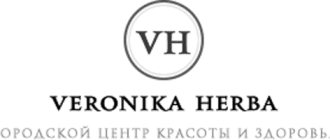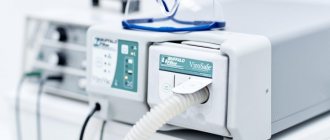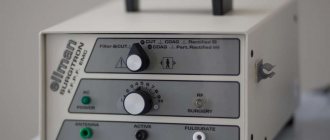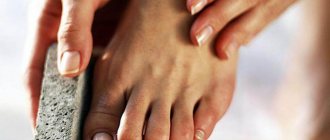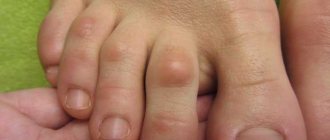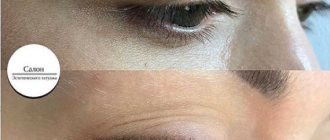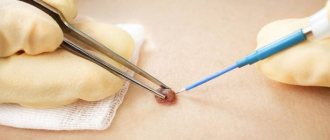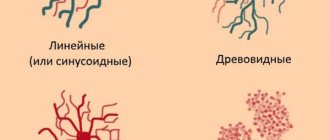An ingrown toenail is a problem familiar to many.
An ingrown toenail (or scientifically onychocryptosis) is a fairly common disease today.
- Specialists
An ingrown toenail is a pathological abnormality in which the nail grows into the nail fold, causing pain and discomfort. According to statistics, every third person faces the problem of an ingrown toenail.
An ingrown toenail can occur for a variety of reasons:
- due to improper care and cutting of the nail;
- uncomfortable, unsuitable shoes;
- mechanical injury;
- flat feet;
- some diseases;
- heredity.
Symptoms that appear with onychocryptosis are redness, swelling of the finger, and pain. In an advanced stage, granuloma or botryomycomoma (“wild meat”) may develop, accompanied by increased granulations of a rich scarlet color, while the area of the nail fold constantly bleeds, and pus is released from under the nail plate.
Causes of ingrown nail plates
In most cases, the nail grows on the big toe; in rare cases, the disease can occur on other toes.
The cause of the disease is anatomically incorrect shape of the nail, improper cutting of nails, wearing narrow and uncomfortable shoes, flat feet, mechanical damage, fungus, etc.
As you know, treatment of any disease is most effective in its initial stage. That is why, in order to avoid serious negative consequences for health, doctors of the MedLine clinic network recommend starting treatment as quickly as possible.
The radio wave method of treating ingrown toenails is unique today due to the complexity of its implementation, since in order to achieve an effect it is necessary to set the correct parameters of radio wave exposure. And only an experienced doctor can do this. An incorrectly calculated radio wave power (insufficient power) can provoke a relapse of the disease, and if the power is too high, the nail can be deformed and grow poorly in the future.
Treatment of ingrown toenails using the radio wave method in the MedLine network of clinics involves the use of radio wave radiation. After anesthesia, the doctor removes the ingrown part of the nail, after which he treats the nail matrix and growth zone with radio waves. The operation does not require stitches, eliminates complications, and has a quick recovery period.
Rehabilitation after laser and radio wave treatment
The patient can go home immediately after the operation; hospital observation is not required. During the first day, the bandage may become moderately wet with ichor - this is normal; if it gets too wet, it is recommended to replace the bandage yourself and apply ice to the finger. The patient is recommended to spend the first day at home, preferably with the leg on a low pad (to reduce postoperative swelling).
In general, rehabilitation occurs quite quickly - the wound heals in 5 - 7 days, after which recovery occurs. The patient can walk normally (provided he wears comfortable shoes) already on the 2nd – 3rd day after the operation. Daily simple dressings are required, which patients usually do themselves. Minor pain may only bother you for 1 day after surgery, and even then it can be easily relieved with conventional analgesics. Antibiotics are rarely prescribed - only for severe purulent inflammation.
Orthonyxia in the MedLine clinic network
Orthonyxia is also an alternative to surgery. The treatment method involves correction of the nail plate using staples, which align the nail plate and redistribute the pressure of the nail to the side fold. Correcting an ingrown toenail using staples is effective even in advanced cases. The installation of staples is carried out by a doctor and is painless.
Recovery period
In order not to provoke adverse consequences, it is necessary to follow all the rules for caring for the damaged area. Under no circumstances should the antiseptic bandage get wet; you should also change the bandage to a new one every three days.
You can do this either independently or with the help of a doctor. During the entire recovery period, approximately two to four dressing changes will be needed.
Approximately one hundred percent healing of the wound can be seen after seven days. People who have a high threshold for pain sensitivity may experience mild discomfort while walking. They can be relieved by taking painkillers.
How is orthonyxia different from nail removal?
As part of the field of outpatient surgery, doctors from the MedLine network of clinics help patients get rid of cosmetic defects of various shapes and sizes: lipomas, fibroids, atheromas, cysts and much more.
- The effectiveness of solving the problem of ingrown toenails in this way is approximately 90%, while relapses are sometimes possible after surgery
. Let us remind you that orthonyxia eliminates precisely the cause of the ingrowth. - There is no risk of being left without a nail
or part of it, as after visiting a surgeon. - There is no need to use anesthesia
. The installation procedure is painless. - No recovery period
. Just half an hour with a podiatrist from the MedLine clinic network - and you can return to your normal routine. - Comfort
. Not noticeable when wearing shoes or playing sports - Aesthetics
. Even with the correction system installed, the nail looks aesthetically pleasing and neat. Some systems can even be decorated with rhinestones or gel polish.
Indications for use
In gynecological practice:
- treatment of erosion, ectopia of the cervix;
- cicatricial deformation of the cervix;
- eroded ectropion;
- cervical hypertrophy;
- treatment of cervical endometriosis;
- leukoplakia of the cervix;
- chronic cervicitis;
- cervical dysplasia degree I;
- condylomas of the vulva, vagina, perineum and perianal area;
- cysts of the vagina and vestibule;
- papillomas of the vulva, vagina;
- dissection of synechiae of the vulva;
- removal of genital nevi.
In proctology:
- removal of anal fissures;
- removal of hemorrhoids.
In dermatology:
- elimination of shallow scars;
- removal of skin tumors;
- removal of papillomas, moles and warts;
- removal of spider veins on the body.
In surgery:
- excision of an ingrown toenail.
In otolaryngology:
- treatment of vasomotor rhinitis;
- treatment of chronic tonsillitis, chronic pharyngitis.
How is the operation performed?
Removal of an ingrown toenail is carried out under local anesthesia, therefore, the most painful thing that the patient can feel is the anesthetic injection. The surgeon cuts off the ingrown nail plate or the edge of the plate and carefully removes granulation growths formed in the area of the ingrown nail. Healthy tissues and the nail bed remain unaffected.
If necessary, excision of the periungual ridges is performed (for cosmetic purposes). Complete removal of the nail plate along with the growth zone is used very rarely, only in cases of severe fungal infection of the nail. The final step is to apply a sterile bandage with an antiseptic.
The classic operation involves suturing the wound - modern electro-radio wave technologies make it possible to do without sutures. The surgical wound heals under the formed crust. The absence of a seam provides a good cosmetic effect, no scars in the area of intervention.
Healing takes from several days to 1-2 weeks. The procedure takes only 20-30 minutes, is less traumatic and minimizes relapses in the future.
You have questions? We will be happy to answer any questions Coordinator Tatyana
Preparation, diagnostics
The clinical picture of the disease is quite specific, which allows the doctor to make the correct diagnosis by visual examination. As a rule, no additional research methods are required. Standard preoperative preparation includes:
- blood analysis;
- if the cause of an ingrown nail is a fungal infection, an additional microbiological analysis of a piece of the nail is performed;
- in case of severe inflammation, if there is a suspicion that the pathological process has affected bone tissue, an x-ray is prescribed
Since ingrown toenails are in most cases accompanied by tissue suppuration, antibiotic therapy is often prescribed to suppress the infection and prevent possible complications.
Pros of Surgitron
- no black scab is formed, because tissue charring does not occur;
- there is no increased wound discharge;
- no additional treatment of the cervix is required to improve reparation;
- healing takes place under the film, which is torn off on the 7-8th day, which is accompanied by minor bloody discharge;
- there is no bleeding after the scab is rejected;
- high clarity of histological samples.
One of the main advantages of the method is visual control of the electrode during exposure to tissue, which allows you to adjust the area and depth of exposure.
Compared to electrocoagulation, the epithelization process when using the Surgitron device proceeds 2-2.5 times faster . The use of diathermic coagulation (electronic knife) causes severe thermal damage to healthy tissues with the formation of a 2-3 degree burn and a demarcation line that separates necrotic tissue from healthy ones.
Reviews:
Barkalov Sergey
I suffered with the problem of an ingrown toenail for almost a month. When the pain became completely unbearable, I began to look for where I could be cured. As a result, I turned to Alexander Shadzhievich. He carried out all the procedures and follow-up superbly. I'll be honest, I was very nervous and worried about the operation. But the whole process, surprisingly, was almost painless, just like the first days of dressings. Even taking into account my business trips, everything healed quite quickly, the main thing is to follow all the doctor’s recommendations. I am very grateful to Alexander Shadzhievich for the accuracy and attention shown during the treatment.
Margarita
Esenbekov Bek
I contacted doctor Alexander Shadzhievich regarding the removal of an ingrown nail on two fingers after a relapse. I am pleased with the result and express my deep gratitude to Alexander for his professionalism and friendliness. I recommend it if you want to get rid of the problem forever.
Azanov Igor Gennadievich
Since the age of 14 (since 1973), I have had the problem of an ingrown toenail on the big toe of my right foot. Initially, I did not contact doctors. I cut it out myself, which was sometimes extremely painful and was accompanied by suppuration (I applied Vishnevsky ointment). Then the nail grew back and the problem returned. For the first time, the rightmost part of a large nail was removed in a hospital in the 80s. There was no positive result, as with all subsequent surgical removals (several times). In 2006, a private clinic performed laser removal, which also turned out to be unsuccessful. In 2022, I went to a podiatry clinic for advice on preventing ingrown toenails (they don’t do removal there). If it is necessary to remove an ingrown nail, it is recommended to contact Dr. Garmaev A.Sh. 10/12/2019 doctor Garmaev A.Sh. performed a marginal resection of the nail using radio waves, gave qualified recommendations on wound treatment and further nail care. As a result of the operation, for the first time I got rid of subsequent ingrown nails and all the accompanying problems. I express my deep gratitude to doctor Alexander Shadzhievich Garmaev for his high professionalism, attentive and sensitive attitude to the patient’s problem. Sincerely, Azanov I.G. 04/29/2020
Nikita
Hello, I wanted to share my experience.
Since I was 12 years old, I have been tormented by the problem of ingrown toenails. Most doctors said that this is a predisposition and nothing can be done about it. They removed it several times, but after the nail grew back (3-4 months) it all started again. Over the past year, I had my nail removed 3 times, each time the operation was very painful and each time there was a relapse. I must say, I am impressed with the result of Alexander Shadzhievich’s work. Thanks to this doctor, in just 2 weeks my finger acquired a healthy and, importantly, aesthetic appearance. A complex procedure (removal of part of the periungual ridge, removal of part of the mold to correct the direction of nail growth, microwave treatment) prevented the problem from reoccurring. The incision site was sutured, thanks to which the wound healed quickly. A day later I already went to work. Anesthesia injections were made into the base of the finger almost imperceptibly, and then the entire operation was completely painless.
I express my deep gratitude to my savior, a wonderful doctor and a true professional, a doctor of the highest category, Ph.D. Garmaev Alexander Shadzhievich.
Margot
Orhan
Symptoms of the disease
The thumbs of the lower extremities are most often affected. The nail can grow in on both sides, but it mainly occurs along the outer edge. First, there is discomfort, then pain when pressing on the nail plate or periungual fold.
Possible consequences of an ingrown toenail
Failure to go to the clinic in a timely manner or inadequate treatment can lead to the spread of infection and the occurrence of:
- lymphangitis and lymphadenitis (involvement of lymphatic vessels and nodes in the inflammatory process);
- abscess of the soft tissues of the finger (purulent melting of tissue structures with the formation of a purulent cavity);
- osteomyelitis of the phalanx of the finger (damage to purulent infection of bone structures);
- gangrene of the finger (necrotic lesion or tissue death).
Self-medication in the presence of an inflammatory process is not worthwhile. By contacting the clinic in a timely manner, you will protect yourself from dangerous consequences. Particular attention should be paid to patients suffering from diabetes mellitus and atherosclerosis of the vessels of the lower extremities, as they are at risk for the development of complications.
